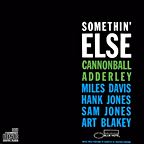Julian “Cannonball” Adderley: Somethin’ Else

Bassist, composer and bandleader Oscar Pettiford was not what you’d call a people person. In fact, he was known for his temper and personnel problems throughout his brief career. So on that fateful night in 1957 at Café Bohemia in Greenwich Village when the sax player was late and a high school band teacher from Fort Lauderdale found himself up on the stage ready to fill in, Pettiford counted off I Remember April at a breakneck tempo, probably figuring he would send the country boy packing.
But this high school band teacher was Julian “Cannonball” Adderley, brother of cornetist Nat Adderley and a firm believer in the Charlie Parker school of thought that there was no such thing as too fast. As jazz historian Leonard Feather puts it in the liner notes, Cannonball “met the challenge with a long solo that just about knocked Pettiford off the stand.” Two days later, he was working full time with the band. Soon after that, he signed with the Savoy label.
Miles Davis regularly attended the band’s performances at the Café Bohemia. “Everybody knew right away that [Cannonball] was one of the best players around,” Davis said in his autobiography, Miles. He and Cannonball went on to play and record together. The 1958 album Somethin’ Else shows what a true collaboration it was—Cannonball was the bandleader, but he and Miles trade solos equally. In fact, when I first heard the disk, I thought it was a collection of Miles Davis repackaged under Cannonball’s name.
Also interesting is how well Cannonball’s hard bop approach and Davis’ cool sound mesh. As a major fan of hard bop’s energy and sharp corners, I can definitely hear the restraint in this album. There are none of the high-speed fireworks that made Cannonball an instant sensation that night at Café Bohemia. But there is amazing, beautiful music, created by two groundbreaking artists.
There is also a palpable sense of time and place, particularly on Davis’ Somethin’ Else and on Alison’s Uncle, a bonus track that didn’t appear on the original album. Close your eyes and you’re in a New York jazz club, probably in some cellar in the Village. The men all sport narrow-brimmed fedoras and Buddy Holly glasses. The women, off-the-shoulder cocktail dresses and Mamie Eisenhower bangs. Everyone is laughing and drinking and smoking, and it’s all in black and white. Yeah.
Back to Blue Kitchen
Leave a comment